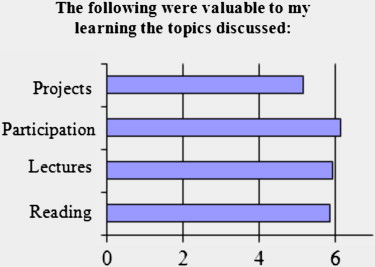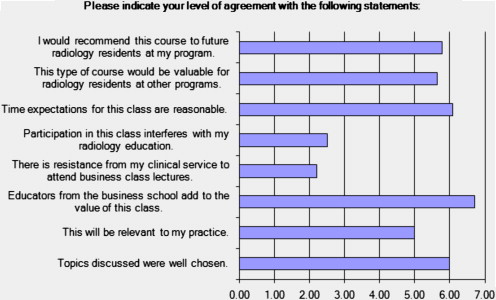This article reports the design, implementation, and evaluation of a new business course for radiology residents taught by business school faculty.
Many radiology residents receive innumerable hours of formal instruction in how to detect lesions, develop differential diagnoses, and make recommendations for appropriate imaging but relatively few hours on the business aspects of radiology practice . Yet the future of radiology hinges in part on how well today’s radiology residents are prepared to tackle the management and leadership challenges that arise in the future, including changing payment schemes, new models for organizing health care, and changing relationships between radiologists and patients, referring physicians, hospitals, and health payers . Some past efforts to address this challenge have relied on radiologists to deliver business education to radiology residents . Others have focused on specific business issues facing radiology residents . Other radiologists have written book-length primers on business and leadership . In this study, we developed and evaluated a course called Business for Physicians for residents taught by full-time business educators.
Our program involved two key components, the first being the introduction of a business course elective into our radiology residency curriculum, for reasons just described. The second innovation was the reliance on full-time business school faculty members to teach the course. This was noteworthy for several reasons. First, we did not enroll residents in a preexisting course. Instead, we developed a brand-new business school course for radiology residents. Second, the course was taught not by radiologists but by business school faculty members, whose sole teaching mission is business education and who therefore bring a particularly high level of experience and expertise to the classroom. Third, residents could apply the credit they earned in the course toward a graduate degree in business. And finally, we actively worked with the business school faculty members to ensure that the course was both relevant and engaging to radiology residents.
Methods
Having discussed the idea of a business course and identified a high level of interest among the residents in our diagnostic radiology residency program, we initiated a series of meetings with the dean and key faculty members at a large university business school located on the same urban campus as our academic medical center. We presented the need for radiologists in training to gain a deeper understanding of the business of medicine, outlined the general content areas we hoped such a course would address, and projected the number of radiology residents in our program we believed would enroll in such a course. After several conversations, the representatives of the business school expressed enthusiasm for the concept, and a single senior business school faculty member assumed primary responsibility for working with us to develop the course. Nine months later, students enrolled in its first offering.
To gain feedback on the course from the residents who enrolled in it, we prepared a 15-question survey instrument using SurveyMonkey (SurveyMonkey, Palo Alto, CA) to which we distributed a link via e-mail to each of the enrollees. Respondents were told that their responses would be automatically anonymized and that their participation was completely voluntary. A single reminder was sent to students who did not respond to the first request.
Twelve of the 15 survey questions assessed the course using a seven-point, Likert-type scale ranging from “strongly disagree” to “strongly agree” , and three asked for free-text responses. Questions included the value of the topics selected, the relevance of the course to the practice of radiology, the value of instruction by business school faculty members, the resistance to class attendance from faculty members on clinical services, the degree to which participation in the course interfered with learning radiology, the reasonableness of class expectations, the value of such a course for other radiology residency programs, and whether students would recommend the course to other residents at their program.
Get Radiology Tree app to read full this article<
Results
Get Radiology Tree app to read full this article<
Get Radiology Tree app to read full this article<
Get Radiology Tree app to read full this article<
Get Radiology Tree app to read full this article<
Get Radiology Tree app to read full this article<
Get Radiology Tree app to read full this article<
Get Radiology Tree app to read full this article<
Get Radiology Tree app to read full this article<
Get Radiology Tree app to read full this article<
Get Radiology Tree app to read full this article<
Get Radiology Tree app to read full this article<
Discussion
Get Radiology Tree app to read full this article<
Get Radiology Tree app to read full this article<
Get Radiology Tree app to read full this article<
Get Radiology Tree app to read full this article<
Get Radiology Tree app to read full this article<
Get Radiology Tree app to read full this article<
Get Radiology Tree app to read full this article<
Get Radiology Tree app to read full this article<
Get Radiology Tree app to read full this article<
Get Radiology Tree app to read full this article<
Get Radiology Tree app to read full this article<
Get Radiology Tree app to read full this article<
References
1. Chan S.: Management education during radiology residency: development of an educational practice. Acad Radiols 2004; 11: pp. 1308-1317.
2. Moore A.V.: Developing future leaders and leadership training in radiology. J Am Coll Radiol 2006; 5: pp. 481-482.
3. Mirowitz S.: Development and assessment of a core curriculum in health care policy and practice. Acad Radiol 2000; 7: pp. 540-550.
4. Collins J.: Noninterpretive skills for radiology residents: job search and contracting issues. AJR Am J Roentgenol 1999; 173: pp. 1452-1457.
5. Berlin J.W., Lexa F.J.: Negotiation techniques for health care professionals. J Am Coll Radiol 2007; 4: pp. 487-491.
6. Fleishon H.: Case for physician executive. J Am Coll Radiol 2005; 2: pp. 652-654.
7. Gunderman R.B., Weinreb J.C., Moore A.V., et. al.: Radiology practice models. J Am Coll Radiol 2008; 5: pp. 960-964.
8. Yousem D.M., Beauchamp N.J.: Radiology Business Practice: How to Succeed.2008.SaundersPhiladelphia
9. Gunderman R.B.: Leadership in Healthcare.2009.SpringerNew York
10. Accreditation Council for Graduate Medical Education. Common program requirements. Available at: http://www.acgme.org/outcome/comp/GeneralCompetenciesStandards21307.pdf . Accessed Nov 5, 2010.

